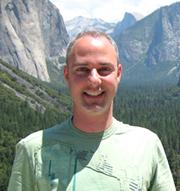
Professor Robert P. Anderson
The New York Academy of Sciences Blavatnik Awards for Young Scientists acknowledge and celebrate the excellence of the most noteworthy young scientists and engineers in the tri-state New York metropolitan region. This year, a member of The City College of New York faculty, Associate Professor of Biology Robert P. Anderson, was chosen as a finalist in the competition.
Professor Anderson is the first CCNY – and first CUNY – faculty member selected as finalist for the awards, which recognize research that is innovative, impactful, and interdisciplinary. He was picked for his work in developing computer techniques for modeling the geographic distributions of species using occurrence records and environmental data. Winners will be announced in November.
“Our lab applies mathematics and computer science to create tools that match the ecological theory and allow us to model with biological data,” he explains. “A geographic information systems (GIS; computer mapping) interface enables us to visualize and process the resulting predictions.” Professor Anderson first used GIS techniques on his doctoral dissertation for his PhD from the University of Kansas, which he earned in 2001.
Much of the species occurrence records he works with come from museums like the American Museum of Natural History (AMNH), where he also holds an appointment as a research associate in the mammalogy department and was a postdoctoral fellow prior to joining the CCNY biology department in 2003. “AMNH has tremendous digital holdings,” he says. “Their collection is a critical resource since it contains much historical data on species’ original distribution.”
His work also draws on an “explosion” in environmental data regarding factors such as climate, soil conditions, and vegetation made by possible by remote sensing and geospatial science. “We take these two data sets and put them together to figure out the environmental conditions that allow a species to survive,” he continues. “In addition, we can predict how species distribution may change due to human-mediated factors such as climate change, land-use change and invasive species.”
Professor Anderson’s techniques were outlined in a paper written in collaboration with Steven Phillips and Robert Schapire, computer scientists with AT&T Research and Princeton University, respectively. Titled “Maximum entropy modeling of species geographic distributions” and published in 2006 in “Ecological Modeling,” it has since been cited in more than 1,000 scholarly articles and reports.
Subsequently, one of his research thrusts has been further developing the approach to make its principles and assumptions clear to anyone doing niche modeling. He is also working with City College colleagues Professors Ana Carnaval and Kyle McDonald on incorporating satellite remote sensing data into these predictions.
“If we can estimate species distributions based on current environmental data, we can apply that model to projections of future climate change to predict whether the species’ range will expand or contract,” he says.
The line of research dovetails with Professor Anderson’s next grant, a study of niche evolution. When related species share a common niche, evolution of climatic tolerances is likely to remain minimal in the next century, allowing predictions of their future range. However, in groups where there is evidence of rampant recent niche evolution, projections across time become meaningless, he adds.
In his laboratory, Professor Anderson has a team of undergraduate and graduate students whom he is mentoring in the principles of species modeling. They spend much time gathering data, especially biological occurrence records and he has taken graduate and undergraduate students to do research in the field. He and Robert Boria, an undergraduate student, spent August in Costa Rica with one of his PhD candidates, Mariano Soley, helping him gather data for his dissertation.
“I want them to understand the reality of where the data comes from, how hard it is to identify species correctly and how precise you need to be to get reliable data ,” he explains.
“Scientific research has payoffs beyond understanding the particular project at hand,” Professor Anderson adds. “Sometimes we come upon issues that are relevant to people working on species elsewhere.” Such has been the case with ecological niche modeling, which led to recognition by the Blavatnik Awards and the New York Academy of Science.
On the Internet:
Professor Anderson
http://tinyurl.com/4yptel5
New York Academy of Sciences
http://www.nyas.org/
MEDIA CONTACT
Ellis Simon
p: 212.650.6460
e:
esimon@ccny.cuny.edu
" rel="nofollow">
esimon@ccny.cuny.edu